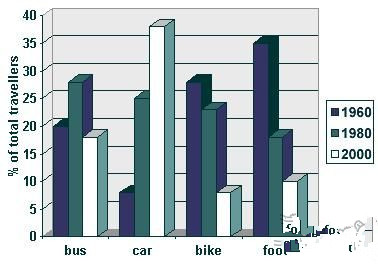

雅思备考规划
扫码添加助教免费咨询雅思备考规划

扫码下载 新东方雅思Pro APP,雅思备考一站式工具
新东方在线雅思频道特为大家收集整理了雅思写作Task1柱状图考官范文(24)。认真研读一定的雅思范文及作文模板可以帮助我们检验自己的写作水平,并能很好地吸收和应用优秀范文里的优秀内容~更多雅思报名官网的最新消息,最新、最专业的雅思备考资料,新东方在线雅思网将第一时间为大家发布。
The graph below shows the different modes of transport used to travel to and from work in one European city in 1960, 1980 and 2000.
Write a report for a university lecturer describing the information below.

Sample Answer:
The provided column graph represents information on travelers’ preferences of vehicles to go and come-back from work in a European city in three different years namely 1960, 1980 and 2000.
As is observed from the figure, car was the widely used mode of transport in the year 2000 than it was in other two decades: 1960 & 1980, and the number of people used to walk on foot earlier, gradually decreased over the time.
In 1960, almost 20 percent people used buses to and from workplaces and this percentage increased to almost 28% after 20 years in 1980. In the year 2000, the bus users fell to less than 20%. On the contrary , in case of private car, the users were only about 7% in 1960, which was the lowest among the 4 transportation systems, and this amount increased sharply in 1980 amounting 25% and in 2000 more than 38% , making it the most used form of transportation system. More than 27% people used bike in 1960 and in 1980 the number decreased slightly by 5% but in 2000 dramatically fall to about 7%. Finally 35% people used to walk to go to work and to return from there. But this foot-walkers number declined significantly at only 18% in 80'S and in 2000 at 10%, probably because of the increased uses of private car.
In conclusion, more people used to walk to travel to workplaces in 1960 but with the increased popularity of private cars this amount became tiny in 2000.
(Approximately 252 words)
(This model answer can be followed as an example of a very good answer. However, please note that this is just one example out of many possible approaches.)
Alternative Answer:
The supplied bar graph gives data on different transportation systems people used in a European city in three decades: 1960,1980 and 2000 and compares how the habit of going to work and returning from there had changed over a 40 years of period.
As described in the graph, with the increased use of cars, peoples' habit of using bikes and walking on foots had decreased significantly over the time.
Initially in the year 1960, lots of people used to move either on foot or using a bike which were 35% & about 27% consecutively compared to only about 7% private cars and about 20% buses. After 20 years in 1980, the number of car and bus users grew up noticeably to 25% and to about 28%.The private car users grew more than 3 times over 20 years and in the same year people traveling on foot fell to less than half as it was in 1960 amounting only 18% of the total travellers. And finally in 2000, only 10% work-goers walked, only about 7% people rode a bicycle compared to 18% bus users and about 38% private car users. In 1960, majority of the people travelled to and from work on foot or using a car but the scenario became completely different after 40 years when most of the people used cars or buses.
(Approximately 224 words)
(This model answer can be followed as an example of a very good answer. However, please note that this is just one example out of many possible approaches.)
本文关键字: 雅思写作Task1柱状图考官范文(24)

 资料下载
资料下载
核心1200词单词卡下载
发布时间:2025-04-15添加新东方在线雅思助教号
回复【单词卡】获取
雅思写作高频词汇PDF下载
发布时间:2025-02-06添加新东方在线雅思助教号
回复【200】获取
590组雅思阅读写作必背短语PDF版下载
发布时间:2023-08-09添加新东方在线雅思助教号
回复【590】获取
雅思学术词汇搭配表PDF版下载
发布时间:2023-08-04添加新东方在线雅思助教号
回复【ACL】获取
雅思口语part3结构策略PDF版下载
发布时间:2023-08-04添加新东方在线雅思助教号
回复【Part3】获取
雅思听力高频场景词PDF版下载
发布时间:2023-08-09添加新东方在线雅思助教号
回复【高频词】获取
雅思口语Part2答案示范15篇PDF下载
发布时间:2023-07-26添加新东方在线雅思助教号
回复【P2】获取
雅思小作文35组必备表达PDF下载
发布时间:2023-07-26添加新东方在线雅思助教号
回复【35】获取
雅思阅读高频短语PDF下载
发布时间:2023-07-20添加新东方在线雅思助教号
回复【短语】获取
200组雅思写作高频词汇PDF下载
发布时间:2023-07-20添加新东方在线雅思助教号
回复【200】获取
雅思写作话题词汇PDF下载
发布时间:2023-07-16添加新东方在线雅思助教号
回复【话题】获取
50组雅思口语同义替换词PDF下载
发布时间:2023-07-10添加新东方在线雅思助教号
回复【替换】获取
雅思写作大作文精选题目101PDF下载
发布时间:2023-07-09添加新东方在线雅思助教号
回复【101】获取
雅思口语核心300词PDF下载
发布时间:2023-06-23添加新东方在线雅思助教号
回复【300】获取
雅思阅读分类词汇PDF下载
发布时间:2023-06-17添加新东方在线雅思助教号
回复【分类词】获取
雅思口语必备习语PDF下载
发布时间:2023-06-17添加新东方在线雅思助教号
回复【习语】获取
雅思小作文常用词汇66词PDF下载
发布时间:2023-06-16添加新东方在线雅思助教号
回复【66】获取
雅思口语常见功能结构109句PDF下载
发布时间:2023-06-08添加新东方在线雅思助教号
回复【109】获取
10年雅思写作题库PDF下载
发布时间:2023-06-08添加新东方在线雅思助教号
回复【写作话题】获取
雅思图表作文精选套句50句PDF下载
发布时间:2023-05-28添加新东方在线雅思助教号
回复【50】获取
雅思写作99组高频词汇PDF资料
发布时间:2023-05-28添加新东方在线雅思助教号
回复【99】获取
2023年5月雅思口语新题题库PDF版本
发布时间:2023-05-14添加新东方在线雅思助教号
回复【新题】获取
2023年5-8月雅思口语新题题库与解析PDF版本
发布时间:2023-05-06关注新东方在线考雅课程中心服务号
回复【新题】获取
雅思听力考点词汇PDF资料
发布时间:2023-04-27添加新东方在线雅思助教号
回复【考点词】获取
雅思听力机经词汇PDF资料
发布时间:2023-04-24添加新东方在线雅思助教号
回复【TL】获取
雅思口语Part1常见话题语料库PDF资料
发布时间:2023-04-20添加新东方在线雅思助教号
回复【Part1】获取
剑桥雅思阅读长难句50句PDF资料
发布时间:2023-04-19添加新东方在线雅思助教号
回复【长难句】获取
雅思阅读核心学术词汇表PDF资料
发布时间:2023-04-07关注新东方在线考雅课程中心服务号
回复【核心】获取
100个雅思写作观点词和替换词表达PDF资料
发布时间:2023-03-24关注新东方在线考雅课程中心服务号
回复【100】获取
雅思阅读分类词汇PDF资料
发布时间:2023-03-22关注新东方在线考雅课程中心服务号
回复【分类词】获取

添加新东方在线雅思助教,
回复【口语】获取雅思口语资料大礼包

 推荐阅读
推荐阅读
雅思大作文是许多准备雅思考试的考生们非常关注的一个部分,它不仅考察考生的语言表达能力,还考察逻辑思维和组织能力,为了帮助大家备考,本文为大家带来雅思大作文:针对儿童的广告越来越多是否应该加以控制。
来源 : 新东方在线雅思 2024-03-27 11:58:44 关键字 : 雅思考试 雅思考试题 雅思写作 雅思大作文
雅思大作文是许多准备雅思考试的考生们非常关注的一个部分,它不仅考察考生的语言表达能力,还考察逻辑思维和组织能力,为了帮助大家备考,本文为大家带来雅思大作文:是否同意国际社会采取行动确保国家减少对化石燃料的消费。
来源 : 新东方在线雅思 2024-03-27 11:53:29 关键字 : 雅思考试 雅思考试题 雅思写作 雅思大作文
雅思大作文是许多准备雅思考试的考生们非常关注的一个部分,它不仅考察考生的语言表达能力,还考察逻辑思维和组织能力,为了帮助大家备考,本文为大家带来雅思大作文:新市镇规划中公园设施是否比购物中心更重要。
来源 : 新东方在线雅思 2024-03-25 18:24:18 关键字 : 雅思考试 雅思考试题 雅思写作 雅思大作文
雅思大作文是许多准备雅思考试的考生们非常关注的一个部分,它不仅考察考生的语言表达能力,还考察逻辑思维和组织能力,为了帮助大家备考,本文为大家带来雅思大作文:是否同意政府应该为儿童超重和肥胖负责。
来源 : 新东方在线雅思 2024-03-25 18:08:59 关键字 : 雅思考试 雅思考试题 雅思写作 雅思大作文
雅思大作文是许多准备雅思考试的考生们非常关注的一个部分,它不仅考察考生的语言表达能力,还考察逻辑思维和组织能力,为了帮助大家备考,本文为大家带来雅思大作文:越来越多的体力工作是由机器完成的利弊。
来源 : 新东方在线雅思 2024-03-25 17:55:51 关键字 : 雅思考试 雅思考试题 雅思写作 雅思大作文










 资料下载
资料下载
添加新东方在线雅思助教号
回复【单词卡】获取
添加新东方在线雅思助教号
回复【200】获取
添加新东方在线雅思助教号
回复【590】获取
添加新东方在线雅思助教号
回复【ACL】获取
添加新东方在线雅思助教号
回复【Part3】获取
添加新东方在线雅思助教号
回复【高频词】获取
添加新东方在线雅思助教号
回复【P2】获取
添加新东方在线雅思助教号
回复【35】获取
添加新东方在线雅思助教号
回复【短语】获取
添加新东方在线雅思助教号
回复【200】获取
添加新东方在线雅思助教号
回复【话题】获取
添加新东方在线雅思助教号
回复【替换】获取
添加新东方在线雅思助教号
回复【101】获取
添加新东方在线雅思助教号
回复【300】获取
添加新东方在线雅思助教号
回复【分类词】获取
添加新东方在线雅思助教号
回复【习语】获取
添加新东方在线雅思助教号
回复【66】获取
添加新东方在线雅思助教号
回复【109】获取
添加新东方在线雅思助教号
回复【写作话题】获取
添加新东方在线雅思助教号
回复【50】获取
添加新东方在线雅思助教号
回复【99】获取
添加新东方在线雅思助教号
回复【新题】获取
关注新东方在线考雅课程中心服务号
回复【新题】获取
添加新东方在线雅思助教号
回复【考点词】获取
添加新东方在线雅思助教号
回复【TL】获取
添加新东方在线雅思助教号
回复【Part1】获取
添加新东方在线雅思助教号
回复【长难句】获取
关注新东方在线考雅课程中心服务号
回复【核心】获取
关注新东方在线考雅课程中心服务号
回复【100】获取
关注新东方在线考雅课程中心服务号
回复【分类词】获取

 编辑推荐
编辑推荐
 雅思新题
雅思新题
 阅读排行榜
阅读排行榜
 相关内容
相关内容